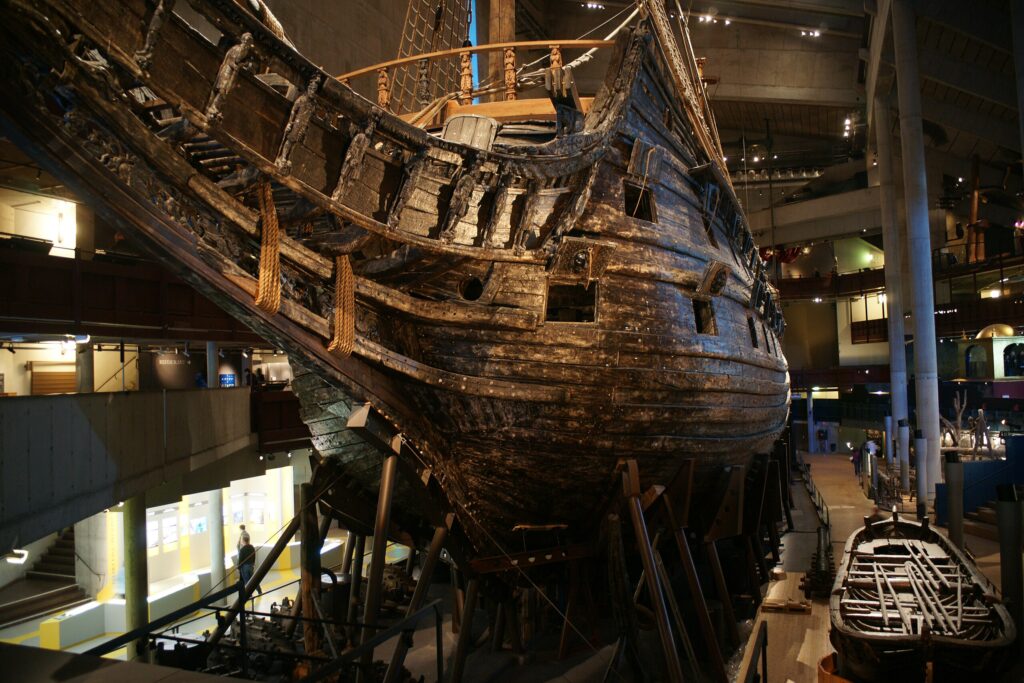In Stockholm, Sweden, there is a museum dedicated to a single ship. Spectacular and awe-inspiring, the Vasa looms over museum crowds, giving them a surreal view of the only fully preserved 17th-century ship.
The effect of looking at the Vasa and wondering what adventures the warship must have undertaken is unmatched. Except…for the Vasa, its only adventures were had long after its sinking. Because the Vasa, the most technologically advanced ship ever built at the time, didn’t even get to complete its maiden voyage.
For the Vasa, all it took was 2 gusts of wind to seal its fate.

Thirty Year’s War and The Building of the Vasa Warship
The year was 1628, and in 2 years, King Gustavus Adolphus of Sweden would be ready to invade the Holy Roman Empire.
For the time being, though, he knew he needed more ships. More of a naval presence was necessary to protect Sweden, but it was also needed to help Gustavus Adolphus remain in control in the Baltic.
He commissioned several ships to be built, but none of them were as spectacular as the Vasa. She was built to put the European ships she would face to shame, with 64 bronze cannons and a crew of 450 men.
Gustavus Adolphus wanted the Vasa, and the rest of his ships, fast. This rush would ultimately be just one factor in the Vasa sinking, but no one could even dream of the doom that would befall their amazing new vessel.
Construction and Design Flaws
That the Vasa was a rush job was just one reason behind the ship sinking.
Another factor was that Gustavus Adolphus was a massive micro-manager. As a king, ship design and construction weren’t exactly his forte. Still, Gustavus Adolphus wanted to have his hands in everything, and couldn’t stop messing around with measurements and suggesting different modifications to the actual professionals.
He tasked shipwright Henrik Hybertsson with the construction of the Vasa, and it was unlike anything the man had built before. Top heavy and packed to the brim with guns, the Vasa was born to fail. For Hybertsson, the Vasa would be his last work. The shipwright died before the Vasa’s completion and could never see it set sail on its maiden voyage, only to sink.
The Sinking of the Vasa
Once complete, they brought the Vasa to the naval port of Älvsnabben for her maiden voyage. It was the perfect day for such an event–wind was light and the sun was shining brightly, illuminating the beautiful woodwork and ornamentation of the ship.
A crowd had gathered, thousands of people, including the King, ready to watch the Vasa in all her glory. And she truly was glorious.
Vasa took to the sea, gliding over the deep blue water and opening her gun ports to fire a salute as she departed Stockholm for open water.
1,130 meters into her maiden voyage, winds filled 4 billowing sails of the ship. Unexpectedly, she heeled hard to the port side, quickly righting herself. It was an odd occurrence, but no one on the shore could anticipate what happened next.
Another gust came, just a little more wind than before, and the Vasa heeled so far this time that water was able to flood the recently opened gun ports. Water came in so dramatically that the Vasa collapsed onto her port side.
The Vasa sank, then and there, only 120 meters from shore. There were 150 aboard, and 30 of them did not survive. The water was so shallow that the masts were still visible above the waves, and survivors clung to them, waiting to be saved by the smaller boats racing to the rescue.
Thus ended the short first life of the beautiful, doomed Vasa. It would be a long, long time before she began her second.
An Ill-Fated Maiden Voyage–Why Did the Vasa Sink?
Gustavus Adolphus was not happy. The Captain of the ship was immediately arrested, and the King was desperate for answers.
To his dismay, there were none to be had. The ship had been manned correctly, so it was not human error on the part of the crew. Instead, the weaknesses lay in the ship’s design itself.
Henrik Hybertsson was the only man who could shoulder the blame…but he was dead. So in the end, no one living was at fault for the sinking, but that didn’t lessen the impact of the tragedy.
A Second Chance: The Rediscovery of the Vasa
333 years later, archaeologist Anders Franzén had a hypothesis that the Baltic Sea was too cold for the shipworm that usually destroys shipwrecks to survive. He was proven correct when he successfully located the well-preserved ships Riksäpplet and Lybska SvanIt. It was 1956 when he found the Vasa, and even before it could be formally identified, it fascinated the public.
Salvaging the Vasa
Salvage was not easy, though. The cold of the Baltic had kept the worms away, but the near-freezing temperatures themselves also helped to prevent decay. The worry was that once the wood of the Vasa hit the open air and began to dry, that deterioration would happen almost immediately.
To combat this, workers kept the ship constantly wet as it was raised from the depths. Amazingly, almost 95% of the wood from the ship was intact. From there, the process of preserving the ship would take a whopping three decades.
The most important part of preserving the Vasa was the application of polyethylene glycol. It was sprayed on the ship over 17 years, and then once that was finished, the Vasa was left to dry for another 9 years.
The Second Life of the Vasa
These days, the Vasa is on display at the Vasa Museum on Djurgarden island in Stockholm. For a ship that didn’t even get to complete its first voyage, the Vasa has become an important part of Swedish history and identity.
Despite its failure, the Vasa is a symbol of the stormaktstiden, or Great Power Period, of Swedish History. Looking at the Vasa, beautiful and immense, one can almost imagine what things were like all those hundreds of years ago.
Now, though, our ships usually last more than one voyage…the Titanic notwithstanding.
References
“Vasa”
https://www.britannica.com/topic/Vasa-warship
“A Swedish Warship Sank in 1628. It’s Still Yielding Secrets”
https://www.nytimes.com/2023/04/08/world/europe/sweden-vasa-warship-woman.html

